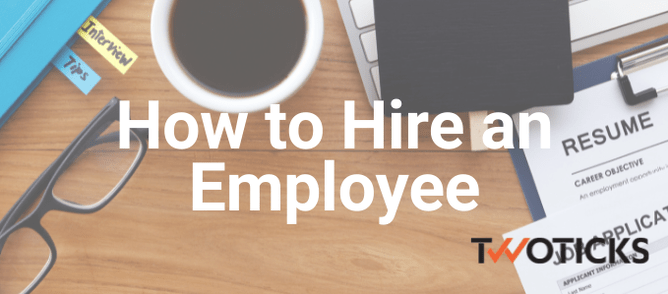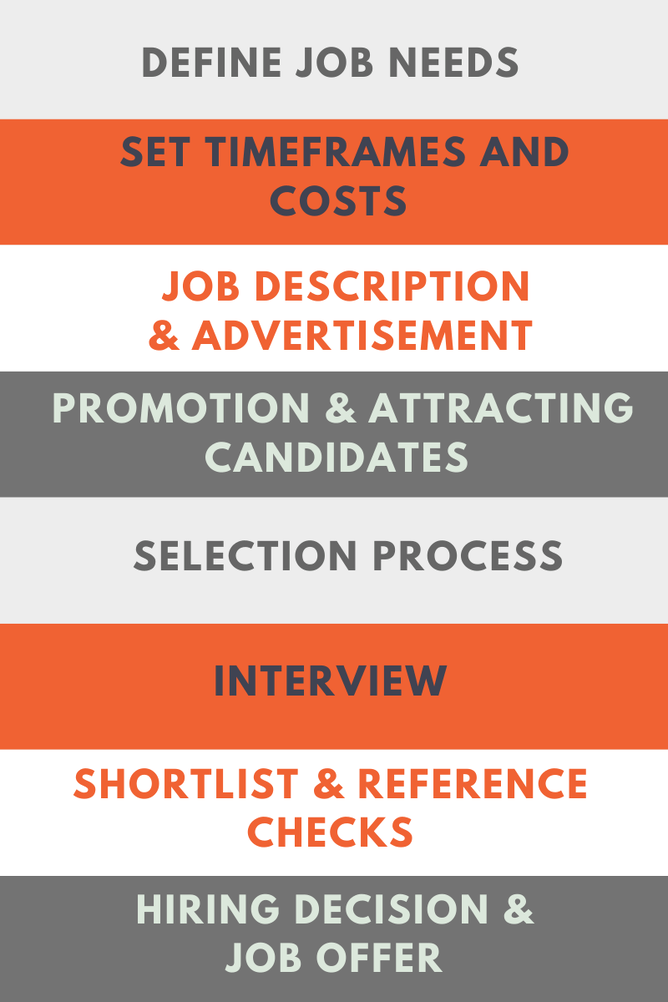A solid team is at the heart of any successful business - the challenge is in finding and then knowing how to hire employees to make your team the best it can be.
The recruiting process is a set of stages with many moving parts:
- Ensuring your job advertisement meets the mark and draws attention
- Selecting the best candidates from a stack of CVs
- Interviewing
- Verifying references
- Selecting your favourite candidate
- Finally making the job offer
Proper preparation and employee recruitment strategies that value the importance of each step are essential.
There are many variables that affect your ability to hire outstanding personnel. If you get it right, you'll have a priceless asset: a person who excels in their job and contributes to the company's growth and development. Get it wrong and you’re stuck with an unsuitable new employee, and you'll either have to spend time and money training and supervising them - or worse, re-do the entire hiring process.
Could your hiring process be improved? Are you missing out on potential applicants because you’re not prepared? We’ll show you ways to streamline and increase your capacity to find the perfect hire. When paired with a clear understanding of the role requirements and your business culture, these techniques will help you with overall employee recruitment and retention.
To learn how to create a recruitment plan, take a look at our helpful tips below.
How to Create a Recruitment Plan
The Best Ways to Recruit Employees:
Getting Started: Define Job Needs
Planning as much as possible before starting the hiring process minimises bumps in the road later on. The first step is outlining and defining the job requirements, including general activities, duties, responsibilities, and overall expectations. This gives you a clear understanding of the type of individual you want to hire as you move through each step of the hiring process.
Set Timeframes and Costs
The hiring process takes time out of your schedule. Background checks, skills testing, and job board listings all rack up costs, as can monitoring and measuring applicant responses. No one wants to waste time and money, so make sure you approve the hiring budget and confirm a plan before you start looking for a new hire.
Traditional recruiting agencies can be costly and time-consuming; as is shouldering the responsibility by yourself - instead, consider alternative hiring solutions like those offered by TwoTicks. An outsourced hiring service saves your business time and money while getting your job ad in front of the right people.
Write the job description and advertisement
The job description is crucial in learning how to hire staff efficiently. It lays the foundation for the overall hiring campaign and clearly outlines the role.
Determine which skills are "must-haves" and which are "nice-to-haves" that can be learned later through professional development. Including your company's culture, values, and expectations will also help you attract suitable candidates. For a consistent approach, ensure all internal stakeholders define and agree upon the job responsibilities and necessary abilities.
Recruitment advertising is competitive - never skimp on the content of your job advertisement, as this is what will capture an applicant’s interest. You can find more useful information and tips by reading our blog post on how to write a job description.
Promoting the job and attracting candidates
When promoting the job and attracting the right candidates, you should first ask:
- Who would you like to apply for the job?
- Why would they be attracted to the position?
- How would they be most likely to find out about the vacancy?
- What information would they be interested in knowing?
It's important to post your job advertisement on the right platforms so they are in front of the right job market and audiences. Even the most appealing job posts may not attract top candidates if it’s not widely publicised or promoted. To reduce your hiring time, put a good promotion plan in place. Proper ad budget management and a decent advertisement delivered on the right websites guarantees that the right people will view your role and that you’ll stand out from other companies' job postings.
Selection process
How do you select the best candidate? Review CVs and shortlist your top applicants while keeping the hiring criteria and job description in mind. Does the candidate have the required qualifications, skills and experience necessary to fill the role? Conducting a brief initial phone or online call gives you an idea of whether they’d be the right fit for the company - without wasting time on a formal interview if they don’t meet your criteria.
Once you have a shortlist, set a timeframe for all interviews. Conducting your in-person interviews on the same day or over a couple of days ensures the candidates stay fresh in your mind.
Interview
A well-planned and effective interview allows you to assess a candidate's ability and expertise for the position as well as gauging if their attitude and values would fit in with the organisation. The major objective is to gather reliable information to evaluate an applicant against the job requirements - well as against other contenders for the position. Make sure you’re present without distractions and take notes to keep track of each individual interview.
Access candidates based on the hiring criteria and cultural fit and ask yourself:
- Do they meet the job requirements?
- Do they need more training?
- Will they get along with the team?
First impressions are crucial but have an open mind before making any final judgments.
Shortlist and Reference Checks
Once the interview process is complete, you'll have the tough choice of excluding individuals to create a final shortlist. This involves evaluating candidates based on their skills, cultural fit, and aptitude, as well as doing reference checks on your final choice. Be objective when evaluating your top contenders and make sure all internal stakeholders agree on the decision.
A reference check is an important component of the recruiting process since it provides unbiased information about a candidate's previous job performance and cultural fit. Many applicants seem great on paper but don't meet the mark in person - or they seem great in person, but you want to verify their claims - so it's critical to follow up on interviews with these reference checks right away, and by calling at least two of a candidate’s referees.
Final hiring decision and job offer
Don’t keep the top candidates in the dark, as they may lose interest or become disheartened in a slow hiring process. Keep communication lines open and regularly update shortlisted candidates on their progress.
Now that the hard part is over you can make an offer! Finalise the contract and employment package, including salary, leave and other working arrangements and details. Extend the job offer letter as soon as you’ve made your choice. You can then formally welcome your new hire to the team and company and answer any questions they might have about their new job.
To Conclude:
In the current climate, knowing how to hire employees with the proper protocols in place has never been more important. Businesses must be open and honest about their demands and make bold decisions to ensure they find the best recruit. Finding a recruiter with hiring solutions to protect yourself from poor hiring is your best option.
Harnessing the correct techniques, paired with a clear understanding of the role requirements and your business culture, will help you make the right choice. The hiring process can be drawn-out and costly – finding a recruiter with hiring solutions and strategies can save you time, resources and money.
Want more hiring tips and recruitment advice?



